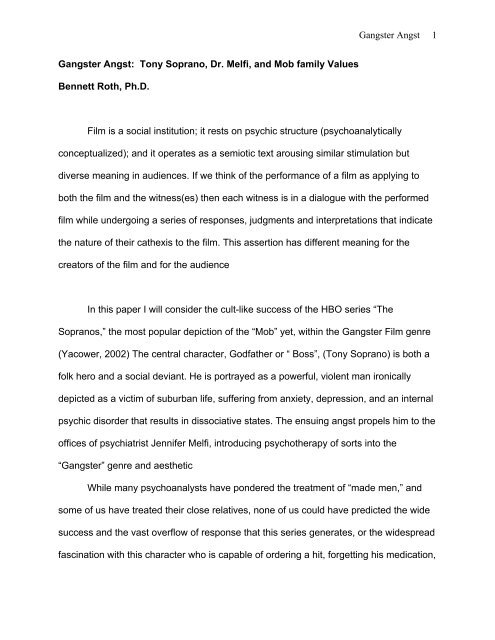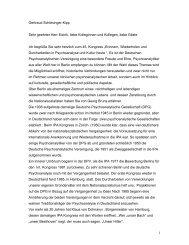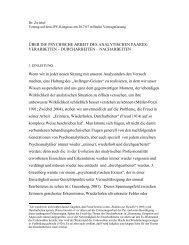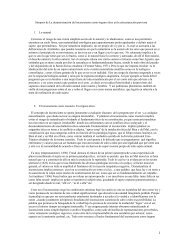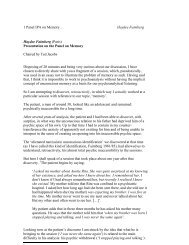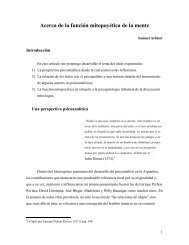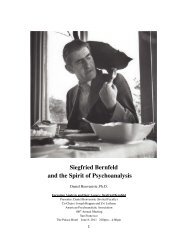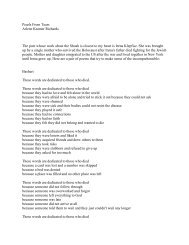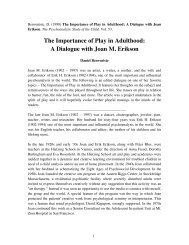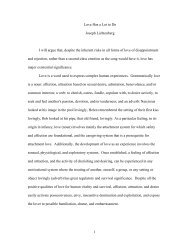Gangster Angst: Tony Soprano, Dr. - International Psychoanalysis
Gangster Angst: Tony Soprano, Dr. - International Psychoanalysis
Gangster Angst: Tony Soprano, Dr. - International Psychoanalysis
Create successful ePaper yourself
Turn your PDF publications into a flip-book with our unique Google optimized e-Paper software.
<strong>Gangster</strong> <strong>Angst</strong>: <strong>Tony</strong> <strong>Soprano</strong>, <strong>Dr</strong>. Melfi, and Mob family Values<br />
Bennett Roth, Ph.D.<br />
<strong>Gangster</strong> <strong>Angst</strong> 1<br />
Film is a social institution; it rests on psychic structure (psychoanalytically<br />
conceptualized); and it operates as a semiotic text arousing similar stimulation but<br />
diverse meaning in audiences. If we think of the performance of a film as applying to<br />
both the film and the witness(es) then each witness is in a dialogue with the performed<br />
film while undergoing a series of responses, judgments and interpretations that indicate<br />
the nature of their cathexis to the film. This assertion has different meaning for the<br />
creators of the film and for the audience<br />
In this paper I will consider the cult-like success of the HBO series “The<br />
<strong>Soprano</strong>s,” the most popular depiction of the “Mob” yet, within the <strong>Gangster</strong> Film genre<br />
(Yacower, 2002) The central character, Godfather or “ Boss”, (<strong>Tony</strong> <strong>Soprano</strong>) is both a<br />
folk hero and a social deviant. He is portrayed as a powerful, violent man ironically<br />
depicted as a victim of suburban life, suffering from anxiety, depression, and an internal<br />
psychic disorder that results in dissociative states. The ensuing angst propels him to the<br />
offices of psychiatrist Jennifer Melfi, introducing psychotherapy of sorts into the<br />
“<strong>Gangster</strong>” genre and aesthetic<br />
While many psychoanalysts have pondered the treatment of “made men,” and<br />
some of us have treated their close relatives, none of us could have predicted the wide<br />
success and the vast overflow of response that this series generates, or the widespread<br />
fascination with this character who is capable of ordering a hit, forgetting his medication,
<strong>Gangster</strong> <strong>Angst</strong> 2<br />
buying a present for his adolescent son, and bringing home Italian pastries, all in the<br />
same day.<br />
As “The <strong>Soprano</strong>s” has achieved cult-like status, the depictions of <strong>Tony</strong> in his<br />
treatment have elicited an enormous amount of controversy within, if not misplaced<br />
honors from, the psychoanalytic community (Gabbard, 2002). The tremendous<br />
response to this show has oddly led the American Psychoanalytic Association to honor<br />
not only David Chase, the series’ creator, but also Lorraine Bracco, the actress<br />
portraying the, frequently inept, therapist, <strong>Dr</strong>. Melfi (Gabbard, 2002).<br />
To understanding of this socially significant cinematic phenomenon it is helpful to<br />
first present a historical perspective of this genre before offering any in-depth<br />
explanation of“The <strong>Soprano</strong>s”. In this manner the media event, like a psychoanalytic<br />
event, does not stand by itself, but appears as part of a stream of interlocking events<br />
comprised not only by its serial form of presentation, but also by its place atop a<br />
stunning American Genre. “Film Genre” as a history of representations is conceived of<br />
as a “frame of reference” (Beres and Arlow, 1974), eliciting unconscious fantasies and<br />
expectations that are unique to each genre. By the conclusion of this essay, I hope to<br />
have demonstrated that the cumulative meaning of the current depiction, the“ The<br />
<strong>Soprano</strong>s,” along with its predecessors— the films composing the <strong>Gangster</strong> genre—will<br />
prove to have greater power and depth, than any other singular cinematic occurrence.<br />
I will offer an analytic perspective on the precedents to the current <strong>Soprano</strong><br />
<strong>Gangster</strong> incarnation, not only to discern the cultural-psychological “values “of past<br />
genre films, but also to suggest how they influence, and are reprised in, the present<br />
depiction. In this case the gangster series title refers to one person, who is the
emotional fulcrum of the film, <strong>Tony</strong> <strong>Soprano</strong>. Mindful of Villela’s summary of<br />
<strong>Gangster</strong> <strong>Angst</strong> 3<br />
psychoanalytic approaches to film (1999), <strong>Tony</strong> <strong>Soprano</strong> will be treated as a mytho-<br />
poetic phenomenon that rests on a fictive psychic structure. This approach will permit<br />
some interpretations—some literary, but mostly psychoanalytic—that have been lacking<br />
in the critical understanding of the series. I hope to avoid the case study method in<br />
which a fictional character is treated as a “real” person, rather than a fictional entity<br />
(Vilella, 1999). I feel compelled to treat the <strong>Tony</strong> <strong>Soprano</strong> characterization, as an iconic<br />
representation that is not only heir to prior “Mob” films, but whose portrayal evokes and<br />
provokes intense psychological responses in the audience. Certain elements are of<br />
particular importance.<br />
The <strong>Gangster</strong> Image<br />
Movie images have a stimulating effect on the nervous system, yet the recall of<br />
non-verbal imagery in general, and visual images in particular, has received scant<br />
attention in the psychoanalytic literature or in the applied areas of psychoanalysis..<br />
Laboratory research indicates that we may “see” the same film while giving meaning to<br />
it idiosyncratically (Hasson, U. et al., 2004). From a visual perspective then while the<br />
same film is witnessed, there is a variable individual dialogue with the constant never<br />
changing film. One result of the dialogue is that certain cinematic images or scenes<br />
remain indelibly in the minds of film lovers, and form a metaphoric code of recognition<br />
and signification: the demented, sadistic smile on James Cagney's face in “The Public<br />
Enemy” as he walks down a rainy street into a restaurant to slaughter a rival gang;<br />
Cagney's dead body propped up and tottering on his mother's doorstep in the same<br />
film, or the irony in his suicidal mania in “White Heat” as he screams, "Made it, Ma, top
<strong>Gangster</strong> <strong>Angst</strong> 4<br />
of the world," before being engulfed in a huge explosion; Edward G. Robinson as “Little<br />
Caesar,” asking "Mother of Mercy, is this the end of Rico?" as he dies; Paul Muni's<br />
perverse jubilation as he fires his first Tommy gun; Al Pacino's stolid face as he hears<br />
the shot that kills his brother in “The Godfather Part II”; Warren Beatty and Faye<br />
Dunaway's bodies bouncing grotesquely in slow motion as they are riddled with bullets<br />
in “Bonnie and Clyde”; Richard Widmark laughing demonically as he pushes an old lady<br />
in a wheel chair down a flight of stairs in “Kiss of Death.” These images evoke the<br />
American <strong>Gangster</strong> film, a protean genre since the early sound era that retains<br />
significance today, unlike its close relative, the Western morphed into the police story.<br />
American audiences have grown accustomed to a fictional “Mob." Mob stories<br />
have, however, changed substantially over the years, adapting to a variety of social<br />
changes, and a subsequent increased taste for violence. Marlon Brando's businessman,<br />
Don Vito Corleone in “The Godfather,” is very different, indeed, from James Cagney's<br />
upwardly Mobile Tom Powers in “The Public Enemy,” and the mythic projections of<br />
“Bonnie and Clyde” or “Al Capone,” movies that created fictional representations of real<br />
people. It is a genre that both explores and honors a certain kind of<br />
masculinity—profoundly violent and sociopathic—and has seldom allotted much space<br />
for women, except for Scorsese’s anti-operatic “Goodfellas” and "Bugsy."<br />
Early precedents seemed to whet a public appetite for vicarious transient<br />
identification with media-enlarged <strong>Gangster</strong> images. D.W. Griffith’s “Musketeers of Pig<br />
Alley” with Elmer Booth is a good example, as is Josef von Steinberg’s late silent era<br />
film “Underworld” with George Bancroft, but the depression era trio of “Little Caesar,”<br />
“Public Enemy,” and “Scarface” (1) in the early 1930's, marked the real beginning of the
<strong>Gangster</strong> <strong>Angst</strong> 5<br />
genre. Each “classic” film within this genre created a male star that was publicly<br />
emulated, respectively, Robinson, Cagney, and Muni, and simultaneously generated<br />
public debate about the ethics of glorifying criminals; two major public responses to this<br />
genre that continue to this day.<br />
The <strong>Gangster</strong> Film<br />
The <strong>Gangster</strong> film is a genre largely associated with America and the Hollywood<br />
filmmaking industry. Originally “<strong>Gangster</strong>” was a rather loosely defined term,<br />
representing the potentially violent toughs on a street corner in a lower class<br />
neighborhood. The term has since evolved and become a synonym for blue-collar<br />
criminals and Mobsters, as well as the name of a current type of music. “<strong>Gangster</strong> Rap,”<br />
which often glamorizes the gang life style].<br />
Filmmakers from other countries have produced individual and noteworthy<br />
<strong>Gangster</strong> films, but the dominant global image of the <strong>Gangster</strong> is American. Among the<br />
reasons for this American monopoly is the hegemony of the Hollywood film industry,<br />
along with a set of complex beliefs associated with American Capitalism, and<br />
widespread conceptions of the U.S. as a country with a strong imperative towards urban<br />
violence.<br />
Any analysis of the basis for the appeal of this genre reveals a widespread<br />
fascination with the means by which certain individuals gain access to, and control over,<br />
other people and resources. Within this context of social power, the <strong>Gangster</strong> film as a<br />
genre can be viewed as a multifaceted text that reveals its conceptual basis indirectly.<br />
Many distinct parts contribute to the whole of the genre as a representation; anti-
<strong>Gangster</strong> <strong>Angst</strong> 6<br />
establishment individualism, male sexual power, sadistic violence, and fear-based<br />
loyalty.<br />
Many of the actors portraying <strong>Gangster</strong>s in film radiate an intense vitality,<br />
contributing considerably to the genre's role in creating important male stars.<br />
Meanwhile, almost ironically, many of the <strong>Gangster</strong> films resemble simple morality plays<br />
or tragedies, in which these powerful and frightening men tend to die violently, in part as<br />
a carry over from the days of film censorship; a time during which the appeal of the<br />
villain could not exceed the super-ego implications of both, his fate, and moral<br />
judgments of his behavior. Even now, free of censorship’s constraints, American<br />
audiences and film makers frequently require punitive moral endings which re-establish<br />
(paternal) order and appease voyeuristic guilt.<br />
The “<strong>Gangster</strong>” Success<br />
The continued success of <strong>Gangster</strong> films raises important questions, and points<br />
to important social and psychological functions of their performance<br />
, while the current success of the HBO series,<br />
“The <strong>Soprano</strong>s,” amplifies these issues. Among these are: the appeal of the kind of<br />
masculinity glorified in these films; the American fascination with outlaws; the relation of<br />
screen <strong>Gangster</strong>s to their real-life counterparts; and the slow ascension of <strong>Gangster</strong>s<br />
into the (pop) culture of our time. In addition, the huge appeal of the genre points to its<br />
place in the American film industry, its relation to other masculine genres, particularly<br />
the Western and film noir, as well as its role in the creation of male stars who are<br />
frequently emulated in both dress and language. (Footnote: D. Remmick reported how
young toughs would replay the Godfather series, rehearsing the movie line and<br />
<strong>Gangster</strong> <strong>Angst</strong> 7<br />
emulating the clothing, thereby creating reciprocity between the real and the imaginary.)<br />
It also raises questions regarding the vicarious identification (cathexis ), among<br />
individuals and groups, with the “<strong>Gangster</strong>” as an image of maleness, in spite of his<br />
cinematic fate. Finally, exploring shifts in depictions over time in the <strong>Gangster</strong> film genre<br />
allows the construction of inferences regarding both, social and psychoanalytic beliefs,<br />
and values that govern human aspirations and destinies.<br />
A wide-angle view of a number of actors and activities, rather than a single film,<br />
gives greater power to the interlocked and interlocking axis of representations of<br />
maleness, potency, and power cinematically accessible for identification. The fierce<br />
individualism of the Depression era <strong>Gangster</strong>s (as in Murder, Inc., and Public Enemy)<br />
has been transformed into the more corporate mind set of some of the <strong>Gangster</strong>s in the<br />
post-war era (such as those portrayed in The Asphalt Jungle and The Godfather). An<br />
examination of the progression from the nostalgia-influenced films of the 1960's and<br />
1970's (Bonnie and Clyde, Dillinger, Once Upon a Time in America) to the ruthless<br />
images of violence In the service of being the overlord (<strong>Soprano</strong>s, King of New York,<br />
Scarface (2), Godfather, Untouchables) yields a complex yet surprisingly revealing<br />
trajectory.<br />
Each film’s development rests on the prior thematic structure of the genre: The<br />
theme of social upward mobility for outsiders was replaced by “Corporate American”<br />
values, which were, in turn, replaced by an excessive presentation and enjoyment of<br />
violence. David Chase’s creation, with James Gandolfini’s uncanny personification of<br />
<strong>Tony</strong> <strong>Soprano</strong>, is the current and composite heir to this series of <strong>Gangster</strong> images.
Mob Violence<br />
<strong>Gangster</strong> <strong>Angst</strong> 8<br />
One possible solution to understanding the series success is try to understand<br />
the appeal of violent processes in the media, and their meaning, both within our culture,<br />
and for the individuals attracted to them. Almost all events in reality are overshadowed<br />
by the seemingly endless expression of male violence in the modern cinema. Mob<br />
violence is a direct challenge to the state’s monopoly on the use of force and violence.<br />
For Americans this challenge is only dimly perceived. The psychological horror of<br />
cinematic violence seems to rest in the recognition that these crimes are committed by<br />
our “Doppelgangers”, our doubles in the culture, induced by the mirroring device of<br />
television. This violence is seemingly committed in the name of enforcing Mob values,<br />
but must also be considered as the source of a divergent culture’s pleasure and<br />
entertainment.<br />
In <strong>Gangster</strong> films, murders, as frequent plot devices, are tolerated because<br />
personal violence is both nurtured by American fantasies, and acted out by our<br />
delegates in modern entertainment. Film, television in its various forms, professional<br />
sports and contemporary music all make the point repeatedly, that violence empowered<br />
by amoral values is personal, virulent and lethal. It must be considered that there is a<br />
potent psychic relationship between the cultural imagery of amoral violence and the<br />
appeal of these sociopathic tendencies that contributes to the creation of “The<br />
<strong>Soprano</strong>s” as a mythical icon within our culture. But looking deeper, and perhaps<br />
analytically, into this phenomenon, because for this popularity to occur, it takes a<br />
remarkable combination of social familiarity, historical amnesia and selective excitation
<strong>Gangster</strong> <strong>Angst</strong> 9<br />
for “Mob Values” to be internalized as social fantasy, and a shared pleasurable viewing<br />
experience.<br />
Given the pervasive use of violence in film it is undeniably attractive to<br />
audiences. It’s attraction and seductiveness in gangster films is likely genderized with<br />
males choosing violent films (Roth, 1997) Destructive violence ultimately has the allure<br />
of a god-like power that sanctions a license to kil violentlyl or destroy with impunity. This<br />
power stands in contrast to and is most appealing to many in the audience with dead<br />
end jobs and powerful social inhibitions. Killing can be intoxicating and empowering.<br />
While many view violence with alarm gangsters (in film) seem to have either a naïve or<br />
smug belief in their own invulnerability and a constant wish to violate social taboos. I<br />
believe that the violence occurs because these (film) people are without awareness of<br />
their own psychic reality. In its place is a dependence on each other, the “Mob “ and the<br />
“ Boss.” This combination of internal emptiness and external reliance yields a complete<br />
confusion between private and secret. This intern permits a violent protection of the<br />
secret.<br />
Within the narrative of film the control of violence rests with the boss who<br />
approves, condones and often selects the targets of the murderous violence. Although<br />
in the <strong>Soprano</strong> series impulsive violence occurs frequently. Often the act of murder is<br />
assigned to a particular individual who takes on the persona of the cold killer, the “Angel<br />
of Death”. Warshow (1959) takes the important perspective that violence is used to<br />
advance the” Ganster’s” greedy wishes and remove competition, while I believe that<br />
violence is also used to support the code of “ silence” so often appealed to in these films
<strong>Gangster</strong> <strong>Angst</strong> 10<br />
as necessary for the gangsters survival that is the symbol of their dependency on the<br />
gang and on secrecy.<br />
While increasing violence may have emerged with the early films, it was not until<br />
the operatic, cinematic saga “The Godfather” appeared, that the social meaning of the<br />
<strong>Gangster</strong> film took on the aura of a modern fable, which afforded the average male<br />
citizen the opportunity to create a symbolic illusion of Mob-family values. One can look<br />
at the earlier significant <strong>Gangster</strong> films, not only as presenting the scaffolding upon<br />
which “The Godfather” films depended, analogous to a family history, but one in which<br />
earlier verbal or visual elements are reprised in homage in the <strong>Soprano</strong>s series,<br />
perhaps in the same form that ancestors are remembered and honored.<br />
Mob values, as derived from these films, are masterpieces of illusion based on a<br />
group culture that like adolescents makes up its own rules. An inventory of the roles and<br />
values of <strong>Gangster</strong>s in films must yield several relatively simple models embedded in<br />
the cinematic process that appear whole, but are a fragmented system of thought.<br />
These models can only be united on the level of fantasy by the audience. This<br />
emulative behavior is repeatedly reprised in the <strong>Soprano</strong>s series, with characters using<br />
well known Godfather phrases, or enforcing actual “<strong>Gangster</strong>” conventionalities, as in<br />
one comic scene where a character misquotes the well known ‘Lucca Brazzi” phrase,<br />
only to be corrected by an older companion. D. Chase, the originator of “The <strong>Soprano</strong>s,”<br />
knowingly uses these, and other cryptographic historical texts, not only to tie this series<br />
to its historical precedents, but also to forge a contemporary model tied to the genre’s<br />
core symbolic systems. Reconstructing and psychoanalytically decoding “The<br />
<strong>Soprano</strong>s”’ cinematic symbolism through its first four years requires a reviewing of the
<strong>Gangster</strong> <strong>Angst</strong> 11<br />
50 minute episodes. In a general manner, such an analysis reveals that sudden<br />
murderous violence, paranoia, and degradation of both, women and marital values,<br />
represent a seeming total devaluation of the individual within a system organized with all<br />
of the social partitioning of an iconic tribal society. It reveals an organization of males in<br />
which kinship and loyalty to the monarchic “Boss” are valued above everything else. Its<br />
familiar totalitarian pattern is revealed over time; total power derived from violence and<br />
menace, and total authority to dominate and direct lesser men who are possessed by<br />
anxiety and greed. This façade of order and violence, often an open secret ,while not<br />
offering its viewers a solution to anxiety over one’s position in society, does provide a<br />
structure, which offers instead the possibility of an end to personal dissonance, and the<br />
neutralization of any inherent personal or psychic struggle. In the world behind the<br />
façade of <strong>Gangster</strong> activities, the “Boss” or “Old Man” is presented as a derivative of the<br />
character the Wizard of Oz, residing in a paranoid world of manipulated symbols and<br />
antitypes. However, this Wizard is sadistic, meting out violent punishments for those<br />
who either break his code, or present a rival menace.<br />
Cinematic Mob culture, existing within the socioeconomic framework of<br />
capitalistic societies, seemingly arose as a caricature of the society in which it was, and<br />
remains, embedded. Being a “<strong>Gangster</strong>” is, first and foremost, being a ruthless capitalist<br />
(Warshow, 1959), as is echoed in the oft-repeated phrase from “The Godfather,” “It’s<br />
only business.” <strong>Tony</strong> <strong>Soprano</strong> lives by his own rules and morals in his own corporate<br />
kingdoms, embracing opportunistic capitalistic myths that are rooted in a belief in the<br />
eternal power of American capitalism and force; emulating an American capitalism<br />
instituted by its “Captains of Industry” who conform to psychoanalytic notions of the
<strong>Gangster</strong> <strong>Angst</strong> 12<br />
exception. Such leaders leave the people of the middle class, and middle management,<br />
anxious about their roles and places on the stage of life. In seemingly Adlerian<br />
compensation, we are given, in <strong>Tony</strong>, the physical persona of an anti-corporate type; a<br />
man who thrives through acting upon his violent and sexual wishes that, within a normal<br />
shame/guilt punishing society, are contained by repression.<br />
These constructions elaborate the existence of an underworld empire; one that<br />
emerges from a Renaissance fountain of myths whose aim is to simultaneously mystify<br />
the Boss’s personal sources of power, and his power to corrupt. A new, second-<br />
generation immigrant superman has been crafted as the successor to his urban,<br />
foreign-born, upward-seeking, cinematic fore-bearer, with diverse features of protector,<br />
enabler, and menacer; a sexual, swaggering golem, through which, by transient<br />
identification with him, anxious and repressed men from the capitalistic society could<br />
find some relief for their failure and anxiety. This relief is generated not only by the<br />
imaginary <strong>Tony</strong> <strong>Soprano</strong>’s* personal ability to behave in ways that others can only<br />
imagine, but also by the way in which he shows the members of the middle class the<br />
soft underbelly of other cultural forces. Through his doing business with corrupt<br />
politicians, etc., he generates felt anxiety concerning all forms of social institutions—the<br />
jury, the police, the poverty programs, etc.—by indirectly attacking all of the safeguards<br />
constructed by middle class, white, non-ethnic America. His attacks are, paradoxically,<br />
against both possible social disorder and social order. The moral “justice” and “fairness”<br />
that the members of society project onto these institutions are seemingly nullified by his<br />
ability to corrupt: <strong>Tony</strong>’s behavior is beyond repression and inhibition.
<strong>Gangster</strong> <strong>Angst</strong> 13<br />
As the monied classes migrated to the suburbs to enjoy the fruits of their work,<br />
the movie <strong>Gangster</strong> icon, in his turn, moved from his cinematic primal haunt—the club<br />
or corner of the ghettoized ethnic city—to the spacious tree-scaped land of private<br />
homes and private schools, thereby creating a new minting of the myth of the suburban<br />
father to replace the earlier, and now disappearing, myth of the European immigrant<br />
father, while orchestrating a symbolic change in the cultural and psychological<br />
representations, of male sacrifice and subordination, to fit the new surroundings. Multi-<br />
car garages and suburban values replaced back alleyways, and the old values, which<br />
had excluded anything in contradiction of its form of narcissism. Suburbia, as the<br />
imagined rural American landscape, lacks the shady and darker elements that<br />
composed the comfortable landscape of film noir and the <strong>Gangster</strong> film, despite the<br />
cruel ironic representations of weak fathers found in “American Beauty. In its place are<br />
innovative character types and extreme characterizations of gang members which stand<br />
in contrast to the homogeneity of suburbia. The evidence for this is the substitution of<br />
Aesthetic sense and its replacement by fashion.<br />
Just as the current sit-com characters are patterned on commercial advertising<br />
models looking beyond the viewer into some distant space, the <strong>Soprano</strong>s’ sets<br />
subliminally juxtapose the characters’ glowering and swaggering, not only alongside<br />
suburban highways, bridges to the ethnic city, but also into assisted living homes,<br />
suburban restaurants, New England college towns, and psychiatrists’ offices. Rather<br />
than embracing the traditional upward pathways to success, as defined by persisting<br />
middle class guide posts in post World War 11 America, <strong>Tony</strong> <strong>Soprano</strong> embodies<br />
shared fantasies whose autocracy is based upon his ability to ”live out” his violence and
sadomasochistic eroticism, while seemingly maintaining the integration of his<br />
<strong>Gangster</strong> <strong>Angst</strong> 14<br />
personality, his organizational family, and his married life. Yet, his integration of the<br />
various and competing elements in his personality make him prey not to psychic guilt or<br />
shame, but also to some hidden psychic disturbance. From this vantage point, <strong>Tony</strong>’s<br />
behavior towards <strong>Dr</strong>. Melfi vacillates between seeking therapeutic help for his<br />
symptoms, and trying to assert and establish his value system in her office. He secretly<br />
fixes her car, kisses her, menaces her boyfriend, and has sexual encounters with<br />
another patient he met in her waiting room; these actions obviously understandable as a<br />
continuation of the process of corruption and attack on values—this time analytic<br />
values.<br />
<strong>Tony</strong>’s Disorder<br />
Because of inherent liberal /psychological-psychoanalytical prejudices, we are<br />
led to think of aesthetic as existing predominately within the confines of privacy. Many<br />
aspects of culture support the view of art, morality and civil rights as a by-product of the<br />
ascension of the psychologically-minded middle classes. Such values have given us the<br />
literary genre of “biography,” and an entire set of individually realized and related<br />
conceptualizations of the importance of the individual in art and society. In<br />
psychoanalysis this has led to the “case study.” In cinema, the melodramatic equivalent,<br />
the recognition of the importance of the individual has been indicated by a character<br />
arriving in, and being recognized by, society, which involves a seemingly internal<br />
struggle between the conceptualizations of self, and the self’s values and narcissistic<br />
concerns (Lasch, 1977). Our ascendant, educated, middle classes imbued the early war<br />
film with the cinematic conceptualizations and core beliefs of heroic sacrifice, from the
<strong>Gangster</strong> <strong>Angst</strong> 15<br />
varieties of piety, security, and the battle of man against nature or external evil, to the<br />
struggles of secular loyalty, anti-mythic battles with internal demands, and quests for<br />
accumulation, progress, or power. Such American tropes are repeatedly expressed in<br />
the popular culture following the establishment of encroaching surburbs<br />
What arose in the media of popular literature following the second world war and<br />
the end of “Romantic values” (i.e., westerns, war movies, <strong>Gangster</strong> films, epics and<br />
women’s films), and is now represented in even more popular films, is not simply a<br />
clashing of competing fantasy systems, which portray America as a fragmented country,<br />
unable to see itself as an organic whole, but a complex internal struggle with competing<br />
unconscious images of gender (identity), intimacy and success. A larger-than-life<br />
representation of maleness emerged which, rather than placing value on going into<br />
battle with a sword, rifle, war club or baseball bat, instead defined maleness in terms of<br />
such interests and activities as guarding the president, living in suburbia, or meeting the<br />
in-laws for dinner. In response to an ongoing softening (feminization) of the male iconic<br />
image, a new cinematic minting created an image of maleness increasingly intoxicated<br />
with itself and violence, and the reemergence of a cult of male stardom and egoistic<br />
self-celebration once reserved only for sport stars. Slowly, the epic hero, once found<br />
regretfully using violence in war and western films, was initially replaced or countered by<br />
the bohemian and outsider, and then by pluralistic multicultural reflections of the<br />
changes in society. Following World War II, the concept of democracy had seemingly<br />
been embraced by Hollywood, as social politics replaced the concepts of “fate,” “blood<br />
ties” and class succession as plot devices. And, while, on the surface, this appeared as<br />
opportunity for all, it also loosed a deeper-level anxiety having to do with intimacy and
<strong>Gangster</strong> <strong>Angst</strong> 16<br />
identity in its myriad aspects and, for our purposes, severe Oedipal struggles in all<br />
possible levels and arenas.<br />
These anxieties were seemingly recast in proper linear order by the operatic<br />
trilogy of “The Godfather,” in which maleness and royal succession of power is<br />
accomplished against the juxtaposed visual background of the “Mob’s” renaissance<br />
rival: the ethnic-religious rituals of piety, and the security of the ongoing presence of the<br />
Catholic Church. Even if the cost of succession is the necessary deaths of those who<br />
block the way, the perpetuation of Mob values, with its lack of ambiguity regarding<br />
violent punishment and the replacement of intimacy with the triviality of mutual<br />
seduction, raises, to an entirely new level, the amount of ego adaptation as an external<br />
carapace required to be able to submit to "The Boss.”<br />
What followed “The Godfather” saga was not a creation of a seemingly new order<br />
of progress and plenty, but a deepening clash of competing fantasy systems within the<br />
genre, from “Bugsy” to “Goodfellas” and “The <strong>Soprano</strong>s.” This genre, closely examined,<br />
reveals underlying fantasy systems, and unconscious male images through which the<br />
thread of paranoid sensitivity to betrayal remains both central and intact; From Michael<br />
Corleone’s paternal protective concern when visiting his father in the hospital, to <strong>Tony</strong><br />
<strong>Soprano</strong>’s anxiety dreams, one of which comically reprises the Godfather asasain<br />
“Lucca Brazzi,” with an image of a fish talking in a dream. In many such instances, D.<br />
Chase directly makes his lineage clear, at least to most of us who recognize and quote<br />
lines of dialogue from, “The Godfather.”<br />
As a cautious modern cinematic case study, the internal tensions of <strong>Tony</strong><br />
<strong>Soprano</strong> emerge in various contemporary forms; from dreams of betrayal, and erotic
<strong>Gangster</strong> <strong>Angst</strong> 17<br />
fantasies of imaginary liaisons, to the displacement of ubiquitous castration anxiety onto<br />
the visiting ducks. The writers’ intent is to help saturate us with the notion that <strong>Tony</strong>’s<br />
violent behavior is not characterologically syntonic. He has, like many liberal<br />
psychoanalytic notions would have us believe, been made impulsive, appealing and<br />
dangerous (even to his therapist) by deeper archetypal and iconic threats against his<br />
masculinity. But, as we learn, not only was he a witness to his grinning father’s removal<br />
of a finger from a recalcitrant butcher, and subjected to his uncle’s relentless demands<br />
for hierarchically-based submission; but later he also had to cope with his cranky, spite-<br />
spitting, Italian mother’s fervent attempts to have him “whacked.“ Considering the fertile<br />
and imaginative minds of the series’ writers, had Nancy Marchand, the gifted actress<br />
who played <strong>Tony</strong>’s mother ”Livia,” not been forced to leave the show due to cancer,<br />
exactly where Chase’s innovative use of the cinematic Bad-Mother-Dearest would have<br />
led remains speculatively unknowable. In other public venues Chase openly admits to<br />
using his own mother as a “partial model” for Livia, putting her “cranky” phrases into<br />
Livia’s dialogue. Creating a mother both dependent upon and seeking the murder of her<br />
own child further corrupts any image of basic security<br />
A cumulative effect of creating such parents for <strong>Tony</strong> through frequent flash-back<br />
scenes creates a seeming psychological portrait of a child who received little narcissistic<br />
gratification or support for developing a generative masculine identity, and, perhaps,<br />
reveals the authors’ ideas of a “substrata” of <strong>Tony</strong>’s neurosis. These biographical<br />
notations in the story give a psychological complexity to the character, cumulatively<br />
offering a hope that <strong>Tony</strong> is treatable by psychological therapy, and importantly that his
<strong>Gangster</strong> <strong>Angst</strong> 18<br />
violent behavior is caused by his neuroses, and therefore understandable, if not<br />
forgivable.<br />
The Boss Rules<br />
In <strong>Soprano</strong> reality, <strong>Tony</strong> “rules,” and he does this, as all Mob bosses do, by<br />
persuading his inferiors to accept his rule by means of his greater intelligence, and his<br />
ability to induce paranoia in those around him, as is portrayed in social drama after<br />
social drama in the series. He is able to rule with a unique proficiency which echoes that<br />
of prior Mob leaders, binding his followers to him through their fear that his mandate<br />
comes from some invisible, historic, paternal source. He is, in calculated revelation, an<br />
agent of self-interest, convincing all that he needs to do what he does, and, by doing so<br />
is following some internal secret logic that escapes his audience, and does not bear<br />
close scrutiny. He seems able to tap into an anxiety of personal freedom in his soldiers,<br />
and of going it alone, with some folksy smiling strategy that compels his underlings to<br />
capitulate in front of him. We assume, according to genre rules, that his underlings must<br />
“work” for him, and be a part of an “earners all “economy. <strong>Tony</strong>’s leadership and<br />
exaggerated capitalistic notions of profit and success are reinforced by his implied<br />
threats of terror and actual acts of murderous violence. Even within this dictatorial<br />
structure there exists a constant inner threat of violent chaos; the chaos of a dependent<br />
group in a state of perennial struggle to remain alive with its “Boss,” and prevent his<br />
assassination by rivals, or imprisonment by agents of the government or moral<br />
authorities. Here are merged two equally important representations; <strong>Tony</strong>’s<br />
unquenchable ambition and his ability to avoid being killed.
<strong>Gangster</strong> <strong>Angst</strong> 19<br />
<strong>Tony</strong> <strong>Soprano</strong> is clearly a creature of Chase’s imagination. Through him we are<br />
able to see an archetypal “Boss,” father and husband, subject to his spouse’s common<br />
anxieties; a cruel businessman who must remain without true confidants. We view an<br />
Italianesque man whose prodigious appetites for food and women, and casually violent<br />
behavior reserved for people outside his home, reveal his orgiastic excesses which are<br />
part of the day-to-day life of a war lord or libertine. Rather than values that are<br />
degenerate, romantic, or noble, rather than spiritual values, Shakespearian, guilty, he is<br />
a new modern “Mob Boss” type; ruling at times as if following some folksy intuitive<br />
principle of social order, wondering where the next “rat” will emerge, or covertly seeking<br />
his own (greedy) ends while privately suffering from some vague neurotic anxiety and<br />
fainting spells. With his facade of family values finally perforated and fallen by plot<br />
device, we wait to see what lies beneath the debris of this fallen suburban family, his<br />
shielding outpost of seeming middle class, comforting, suburban values, and frequently<br />
morning-after home-life, which quietly protect against the symbolic/aesthetic residues of<br />
his personal violence and destructiveness.<br />
Mob values, culled from the entire genre, sanction neither lasting culture,<br />
intimacy, nor good marriages. Absent are representations of values as aesthetic,<br />
symbolic or metaphoric. Mob values replace the skin of the social structures it attacks<br />
with debauchery and homicide, and bring into being the eroticization of both, authority<br />
and personal terror. The dual erotic stimulation serves to incite in-group fantasies of<br />
suicidal impulses, displaced into casual murderous aggression, while anesthetizing the<br />
group through a central exploitation of food and sex as commodity and relief. Sex isn’t<br />
the only commodity; the constant visual reminder of the “girls” who work at his nightclub
<strong>Gangster</strong> <strong>Angst</strong> 20<br />
(The Bing) as producers of (cash) money signifies both as a visible hyper-normal refuge<br />
for security.<br />
Attempting to analyze <strong>Tony</strong> <strong>Soprano</strong>’s behavior and evolution throughout the<br />
series is a complex task, as the award-winning writers have crafted a layered character<br />
over the course of the four years of his existence. However, given that he is a fictional<br />
character, we may make some inferences about his representation of character traits.<br />
He seemingly represents, despite the actor’s (James Gandolfino) folksy, peasant<br />
appearance, neither a mere banality nor hyper-normalcy. There is a crafty juxtaposition<br />
between the way in which he behaves as any man in suburbia, and the way in which he<br />
moves quite easily from opening scenes of picking up the morning newspaper to<br />
inflicting varieties of gratuitous brutality, including killing a man with his own hands. A<br />
banal mind lacks both, the capacity to transform what is ordinary into the unusual, and<br />
the capacity to intuit solutions to social problems that gain the upper hand. Such<br />
ambitious outcomes as <strong>Tony</strong> achieves appear to be continually narcissistic within his<br />
own self-interested Mob culture in which subjective and narcissistic views are often<br />
confused. His behavior (as written and acted) leaves open the possibility of an inner<br />
world, if we can imagine a fictional character as having one, in which there is a<br />
partitioning of anxiety, thought, violence and sexuality. Yet, in many plot instances,<br />
when provoked, betrayed or in danger, the seeming partitions dissolve too easily,<br />
revealing an inexhaustible supply of menace and sadistic rage. To achieve this effect<br />
over the course of the series is both, a credit to Chase’s writing skills, and the believable<br />
acting of the characters.<br />
Some Psychoanalytic Thoughts
<strong>Gangster</strong> <strong>Angst</strong> 21<br />
What remains to be understood, what is central to the continued psychological<br />
appeal of the <strong>Gangster</strong> genre in this country, are the underlying reasons that “The<br />
<strong>Soprano</strong>s” has resonated within our culture, and become one of the most followed<br />
series on TV (Yacowar, 2002). The series obviously emerged from the movie culture<br />
that produced the <strong>Gangster</strong> film; “The Godfather” trilogy in particular. It draws on the<br />
iconic combination of male violence, sexy music and male dominated clubs and groups.<br />
It rests upon the superficial theme and value of individualism that evokes an American<br />
myth of maleness, but a maleness that contains secrets that the forces of socialization<br />
(in these cinematic instances, women and the FBI) do not know. The audience,<br />
however, is privy to that special knowledge, as in most murder mysteries, allowing a<br />
dual transient identification with both, violent perpetrator and innocent female. Yet,<br />
paradoxically, while a kind of mythic maleness is emphasized, an implied threat of<br />
failure, represented by death, deportation, or succession, creates the tension that<br />
results from having knowledge of the possible violent outcomes. The result of all these<br />
forces is a seemingly unruly amalgam of drama, tragedy and comedy, in which the<br />
eruption of violence and crime is followed by the power of released emotions. Cleverly<br />
at times, the violence is underscored by the dramatic countering devices of matter-of-<br />
factness and guiltlessness, displayed by individuals whose inner sense of morality is<br />
seemingly untouched by either remorse or guilt.<br />
Prior attempts by media writers and psychoanalysts to come to terms with the<br />
series and the genre have seemingly been devoid of understanding, and replete with<br />
descriptions such as folksy, ironic or comedic, borrowed theater terms, rather than<br />
capturing the series’ deeper psychological appeal. As a trope, the “Mob Boss,” as
<strong>Gangster</strong> <strong>Angst</strong> 22<br />
spelled out earlier, has a long cinematic history. Film critics have easily found in “The<br />
<strong>Soprano</strong>s” series the earlier iconic salutes to these earlier figures. In particular, the plots<br />
of “The Godfather” trilogy and “Goodfellas” socialize the images of <strong>Gangster</strong>s by having<br />
them encounter both, family, complete with domestic conflicts, and the problems of<br />
succession. This is in contrast to the earlier films that portrayed the <strong>Gangster</strong> in some<br />
“psychologically disturbed” relationship to his mother. In this series, <strong>Tony</strong> <strong>Soprano</strong>’s<br />
mother is made even more monstrous and manipulative, capable of taking her place<br />
within the Mob structure. The ‘ innocence’ of <strong>Tony</strong>’s wife serves as a continuous<br />
contrast to alternative images of Mob related mothers. Chase and his writers are<br />
creative in their construction of frequently-appearing juxtapositions or dualities, such as<br />
innocence and cruelty, or exploitation and nurturance. In this manner they establish a<br />
system of symbolic emotional nodal points that arouse tensions connected to the<br />
internal world of the audience. The writers effectively do this through the creation of<br />
emotionally-charged images and the actions of fictional “people“ who have become<br />
familiar, with which the inner emotional experiences of the audience can resonate with<br />
the rapidly appearing images and action in the cinematic narrative. The characters’<br />
actions, images, themes and artistic devices seemingly stimulate a fortuitous<br />
combination of personal autobiographical expression, and familiarity for the silent<br />
audience. This in turn creates a dramatic ambiguity, allowing the audience to project<br />
their own selves, and their wished-for outcomes and experiences, onto the characters.<br />
A second juxtaposition, eliciting tension, is the balance between destructive and<br />
constructive forces, or, psychically speaking, between destructive aggression and<br />
libidinal expressions. For a successful outcome to take place, in which various forms of
<strong>Gangster</strong> <strong>Angst</strong> 23<br />
identification are possible, a cinematic representation must present the clashing of the<br />
two powerful impulses—good and evil— to give shape and form to the audience’s<br />
internal demonic forces and inchoate terrors, which exist alongside wishes to nourish,<br />
salve, create, and protect. One example is the juxtaposition of food and violence, first<br />
used in “Goodfellas,” which helps to establish this balance.<br />
A third duality starts with the freedom to create and share in an illusionary world<br />
in which one’s appetites can be given full expression. The creation of an illusion of<br />
power, greed, and ambition, in the absence of consequences, in reality gratifies<br />
primitive wishes to enjoy a world or a fantasy in which it is possible to escape both,<br />
consequences and guilt. This wish is encouraged by the lack of a sense of specific date<br />
and time in the narrative—usually used to document an event in “reality”—and by the<br />
frequent scenes in which cast members are viewed while eating. Reality is conveyed by<br />
the suggestion that the forces of morality will intervene, or are at least watching. These<br />
processes are successful only to the extent that the audience is willing to accept the<br />
idea that the cinematic creation is not real, but possesses a symbolic mytho-poetic<br />
virtual existence achieved by the audience’s willingness to treat it “as if” it were real<br />
(Schlockower). Such a suspension of reality testing, the so-called willing suspension of<br />
belief, from a psychic perspective, regressively returns the viewer to a still available<br />
temporary, primordial, internal sharing situation.<br />
The interactive elements shared between the images and the audience also<br />
depend on individual willingness to be regressively open (without defenses) to the<br />
artistic communication, as the audience (aptly) tunes in to “the subject matter” by way of<br />
the familiar emotional resonating, and satisfying metaphorical images and actions.
<strong>Gangster</strong> <strong>Angst</strong> 24<br />
Within this shared temporary internal illusionary reality, the created multiple linguistic,<br />
musical, and visual human forms of the presentation activate the emergence of “similar<br />
but not identical” wishes and fantasies in the audience participants. Either<br />
simultaneously, or in rapid succession, there is an internal fusion and linkage of the<br />
separate fames and scenes into a dramatic narrative whole. In this narrative fusion<br />
contradictions are reconciled; sensation and thought are fused so that internal linkages<br />
to imagery, sound and narrative are aroused, depending on individual “basic core”<br />
sensitivities. The audience members, while all seeing the same images, give meaning to<br />
the cinematic narrative according to an interaction between the familiar and satisfying<br />
metaphorical images and actions, and the individual unconscious wishes and fantasies<br />
(Siomopoulis,1977).<br />
Finally, there is the interplay between the individual and the movie; between the<br />
affectively saturated sensory images and the individual who must be given up, broken<br />
or relinquished. Such separateness allows a reacceptance of an internal “compromise”<br />
with reality in the vicarious observer. The temporarily united or umbilical-like relationship<br />
to the affectively charged units of imagery on the large screen is relinquished, and the<br />
sorting out of differentiation, inside and outside, is individuality re-attained. In such a<br />
manner, contact with one’s own self is maintained<br />
The Appeal of <strong>Tony</strong> <strong>Soprano</strong><br />
Having established a schematic frame of regression and identification in the<br />
series, I hope to now safely turn to a specific understanding of the mythic appeal of the<br />
character of <strong>Tony</strong> <strong>Soprano</strong>. American films are noteworthy for a fascination with the<br />
outsider, the “fish-out-of-water” character, and the sociopath. All these cinematic
<strong>Gangster</strong> <strong>Angst</strong> 25<br />
characters either live outside of, or do not comprehend, the rules by which most people<br />
live their daily lives. The <strong>Gangster</strong> film, among others, fits squarely in this model; one in<br />
which the Mob leader seemingly has the skills to gain power (usually) through violence,<br />
and to exercise his fantasies any time he wishes, while suffering little in the way of<br />
personal consequences. Such characterizations in popular film are so numerous that, at<br />
this time, it may be possible to delve a little further into this phenomenon, and to offer<br />
some explanatory hypothesis as to the nature of identification with such a sociopathic<br />
character.<br />
Allowing for the complexity of the identification processes evoked in the<br />
regressive atmosphere of experiencing movies, the transient identificatory processes<br />
may be understood along a dual continuum of complimentary and concordant, with one<br />
part of the continuum dominating at any given time. For example, from the<br />
complimentary part of the continuum, the identification with <strong>Tony</strong> is a masochistic one,<br />
and includes identifying with the victims of his violence and sexual exploitation. A<br />
person with a dominant concordant identificatory process will identify with <strong>Tony</strong>‘s<br />
“exceptional status,” his rule breaking, and his physical domination and violence. The<br />
continuous characterization over time, created and amplified by the serial presentation<br />
of the images, allows for a deeper, or more complex, psychic audience identification; a<br />
kind of psychic recognition and identification with an imagined internal world in which<br />
aspects of <strong>Tony</strong>’s parents dominate. While I believe this is possible in most<br />
identificatory experiences, in this case <strong>Tony</strong>’s “parents“ have been fictionally<br />
represented in the series in a variety of emotionally charged scenes that evoke the real<br />
and imagined stereotypes of both, the “bad and dangerous mother” and the
<strong>Gangster</strong> <strong>Angst</strong> 26<br />
“philandering and violently castrating father.“ Real and imaginary charged scenic<br />
repetitions in the series create the ongoing opportunity for deeper resonance with the<br />
imaginary character. Such regressive identificatory enjoyment may help account for<br />
some of the show’s success.<br />
Another significant aspect in understanding the meaning of the main character is<br />
the relationship between the series and “tragedy” as a dramatic vehicle. While avoiding<br />
the psychoanalytic discourse on the theories of tragedy, it is clear that the<br />
characterization of <strong>Tony</strong> <strong>Soprano</strong> partially fits the description of the modern tragic hero.<br />
Following World War II, the classical definition of the tragic hero changed into a modern<br />
construct; one in which disillusionment with the limits of love and family, accompanied<br />
by sudden, dislocating outbursts of violence, came to embody tragedy (Almond, 1993).<br />
The central character of the modern tragedy also embodies and carries the tragic theme<br />
of there being no easy solution to the problems of human destructiveness. While classic<br />
tragedy is usually about what happens to morally good and just men who suffer tragic,<br />
unfair punishments, or are crushed by the forces they have sought to defy, <strong>Tony</strong><br />
<strong>Soprano</strong> obviously does not fit that characterization. Rather, he is the lusty and powerful<br />
common man, sprung from “wicked parents,” who, although cleverly avoiding the<br />
punishment he “should” suffer for his wicked crimes, arouses tension in the audience by<br />
eliciting the hope that he will ultimately receive his judgment. The tension of waiting for<br />
punishment is a constant source of enjoyment for the audience (Brooks).<br />
There is more to say about punishment beyond its sadomasochistic trope.<br />
Justice and punishment, in drama and <strong>Gangster</strong> films, is a shoddy device, derived from<br />
bourgeois tragedy and political correctness, in which truth (reality) can not be allowed to
emerge freely from the clash or fateful outcome of opposing forces. In drama<br />
<strong>Gangster</strong> <strong>Angst</strong> 27<br />
punishment may best be understood as a moral compromise imposed from the outside,<br />
so that the final outcome is necessary to maintain a narrowly defined and partisan moral<br />
standard. As both a commoner and a <strong>Gangster</strong>, with prodigious appetites for sex and<br />
food, <strong>Tony</strong> appealingly stands opposed to that punitive reality, escaping not only the<br />
fate of good men, but avoiding the circumstances that would lead to his fall, with only a<br />
small symptom, his anxiety, as the moral price for his pleasure-seeking and greed.<br />
Conclusion<br />
In this paper I trace the history of <strong>Gangster</strong> films as an evolving genre, from its<br />
inception to its latest successful incarnation in the <strong>Soprano</strong>’s series. In so doing, I have<br />
illuminated certain aspects of its historical text, appeal, and impact on audiences of this<br />
form of performance.; a performance in which there is a dialogue between film and<br />
witness, At the emotional center of the American gangster films narrative and visual<br />
gaze of the camera is the powerful personification of one person : of “the Boss” or “the<br />
<strong>Gangster</strong>”. His iconic representation is based on exaggerated images of control over<br />
other person, masculinity and a variety of violent capitalistic know how in which he and<br />
his employees flaunt the social rules of competition and advancement to satisfy their<br />
own greedy ends. Despite the risk in his behavior he has become an American folk<br />
hero. Mob values are based on tribal submission to the chief demanding fearful loyalty<br />
in which the price of betrayal is extinction. The characterization of these values has<br />
become a significant part of American culture and imagery reflecting back to society<br />
both a distorted image of capitalism and of maleness
<strong>Gangster</strong> <strong>Angst</strong> 28<br />
The <strong>Soprano</strong> series rest on a framework of earlier depictions of the mobster “<br />
heros while adding family and conflicts to the Boss’s every day life. In addition, in the<br />
series, <strong>Tony</strong> <strong>Soprano</strong> is depicted as having psychological problems both as a plot<br />
device to create the illusion that his symptoms and behavior are psychologically<br />
determined an to bring him into conflict with another middle class icon: psychotherapy .<br />
The possible vanes of various types of identification that take place in viewers of this<br />
complex <strong>Gangster</strong> series are discussed to amplify concordant and complimentary<br />
fantasies.<br />
Certain elements of the series are of particular importance within the dialogue<br />
with its audience . Among them are the regularly appearing intimate violence that is a<br />
mark of gangster series. The cathartic value and manifest meaning of such personal<br />
violence creates the illusion of an “underworld” in which the usual social values of<br />
middle class life are held up for evaluation by the creation of its cinematic antagonist.<br />
The power of “the Boss” creates a totalitarian social structure that usurps the states<br />
rights either to use killing as a device to control behavior or share in the profits from<br />
businesses. In addition, such violence effects the perception of social values and the<br />
role of women within the family.<br />
The performance of violent, sexual and other forms of excesses are<br />
representations that encourage transient complimentary and concordant identifications<br />
resulting in a form of attachment to the character , the series and the hoped for an<br />
outcome that permits the “boss” from receiving punishment.
Cinematic Bibliography<br />
<strong>Gangster</strong> <strong>Angst</strong> 29<br />
Arkoff, S., Feitshans, B., Gordon, L. & Papazian, R. (Producers), & Milius, J. (Director).<br />
1973. Dillinger [Motion picture]. United States: American <strong>International</strong> Pictures.<br />
Balaban, B. (Producer), & Balaban, B. & Rosenberg, S. (Directors). 1960. Murder, Inc.<br />
[Motion picture]. United States: 20 th Century Fox & Princess Pictures.<br />
Beatty, W. (Producer), & Penn, A. (Director). 1967. Bonnie and Clyde [Motion picture].<br />
United States: Warner Bros. Seven Arts, Inc. & Tatira-Hiller Productions.<br />
Beatty, W., Johnson, M., Levinson, B. & Newirth, C. (Producers), & Levinson, B.<br />
(Director). 1991. Bugsy [Motion picture]. United States: Baltimore Pictures,<br />
Desert Vision, Mulholland Productions & Tristar Pictures.<br />
Bregman, M., Saphier, p. & Stroller, L. (Producers), & De Palma, B. (Director). 1983.<br />
Scarface [Motion picture]. United States: Universal Pictures.<br />
Coppola, F.F., Frederickson, G., Fuchs, F., Gage, N., Gefter, M. & Mulvehill, C. et al.<br />
(Producers), & Coppola, F.F. (Director). 1990. The Godfather: Part III [Motion<br />
picture]. United States: Paramount Pictures & Zoetrope Studios.<br />
Coppola, F.F., Frederickson, G., Roos, F. & Skager, M. (Producers), & Coppola, F.F.<br />
(Director). 1974. The Godfather: Part II [Motion picture]. United States:<br />
Paramount Pictures.<br />
De Fina, B., Pustin, B. & Winkler, I. (Producers), & Scorsese, M. (Director). 1990.<br />
“Goodfellas” [Motion picture]. United States: Warner Brothers.<br />
Edelman, L. (Producer), & Walsh, R. (Director). 1949. White Heat [Motion picture].<br />
United States: Warner Brothers.<br />
Frederickson, G. & Ruddy, A. (Producers), & Coppola, F.F. (Director). 1972. The<br />
Godfather [Motion picture]. United States: Paramount Pictures.<br />
Griffith, D.W. (Director). 1912. The Musketeers of Pig Alley [Motion picture]. United<br />
States: Biograph Company.<br />
Hartwick, R. & Linson, A. (Producers) & De Palma, B. (Director). 1987. The<br />
Untouchables [Motion picture]. United States: Paramount Pictures.<br />
Hawks, H. & Hughs, H. (Producers), & Hawks, H. & Rosson, R. (Directors). 1932.<br />
Scarface [Motion picture]. United States: Caddo & United Artists.<br />
Hornblow, Jr., A. (Producer), & Huston, J. (Director). 1950. The Asphalt Jungle [Motion<br />
picture]. United States: Metro-Goldwyn-Mayer (MGM).
<strong>Gangster</strong> <strong>Angst</strong> 30<br />
Kohlmar, F. (Producer), & Hathaway, H. (Director). 1947. Kiss of Death [Motion picture].<br />
United States: 20 th Century Fox.<br />
Mancini, C. & Milchan, A. (Producers), & Leone, S. (Director). 1984. Once Upon a Time<br />
in America [Motion picture.] United States: Embassy <strong>International</strong> Pictures, PSO<br />
<strong>International</strong>, Warner Brothers & Wishbone, Italy: Rafran Cinematografica.<br />
Schulberg, B.P. & Turnbull, H. (Producers), & von Sternberg, J. (Director). 1927.<br />
Underworld [Motion picture]. United States: Paramount Famous Lasky<br />
Corporation.<br />
Wallis, H.B. & Zanuck, D.F. (Producers), & LeRoy, M. (Director). 1931. Little Caesar<br />
[Motion picture]. United States: First National Pictures, Inc.<br />
Zanuck, D.F. (Producer) & Wellman, W.A. (Director). 1931. The Public Enemy [Motion<br />
picture]. United States: Warner Brothers.<br />
Almond, R. (1993). Tragedy, Contradiction and Repression. Psychoanalytic Quarterly<br />
62. 674-677<br />
Beres, D. & Arlow, J. A. (1974). Fantasy and Identification in Empathy. Psychoanal Q.,<br />
43:26-50<br />
Gabbard. G. The Psychology of the <strong>Soprano</strong>s. Basic Books New York New York 2002.<br />
Hasson,U. Nir Y., Levy I., Fuhrmann, G, and .Malach,R. ( 2004). Intersubjective<br />
Synchronization of Cortical Activity during Natural Vision. Science V.303 March<br />
pp. 1634-1640<br />
Lasch, C. (1979). The Culture of Narcissism. Norton. New York.<br />
Remmick D. (2001). Wiretapped Conversation “ Is this the End of Rico “ The New<br />
Yorker. April 2, pp. 38-44.<br />
Roth, B. (1997) Violence The Western Way. Psychoanalytic Review. 84, 743-751
<strong>Gangster</strong> <strong>Angst</strong> 31<br />
Siomopoulis, G. (1977). Poetry as affective communication. Psychoanalytic Quarterly<br />
46. 499-513<br />
Villela, L. (1999). From Film as Case Study to Film as Myth. Annual Psychoanal,<br />
26:315-330<br />
Warshow, Robert (1959) The Westerner In Film : An Anthology ( ed. Talbot , D.)<br />
University of California Press. Berkeley, California .<br />
Yacowar,M. (2002) The <strong>Soprano</strong>s on the Couch The Continuum <strong>International</strong><br />
Publishing Group New York New York 2002


